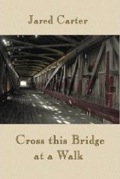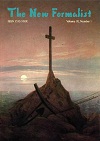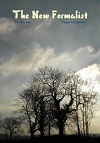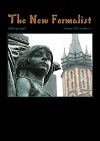“The truth is more important than the facts.”—Frank Lloyd Wright
Every week whatever pittance Marty earned would go for canvas, paint and large stretchers. He would go back to Pete’s empty apartment after work and construct these embryo paintings, carefully measuring the doors and turns on the stairs to make sure he could get them out of the building. He slept on the floor; for food he visited his friends. By the end of the year he hoped to have enough canvases on which to paint a show that would wow even the Guggenheim! But that’s another story.
Though Marty was one of those guys who cared nothing for clothes, he had a flair for the dramatic. I won’t easily forget his tarnished pair of wire rimmed glasses, taped together and perching precariously on his nose, emphasizing his blinded eye with their off-center refractions. By some stroke of fate he had acquired a beat-up but still magnificent Brooks Brothers Harris tweed jacket at the Salvation Army. This functioned as an overcoat for him in the New York winter.
Everybody seemed to be scouring the galleries for one of those stiff little pieces of Guggenheim invitational cardboard, and I could probably have sold my invitation for big bucks. A nice little RSVP card was enclosed, which Uncle Marty desperately wanted. We called him “Uncle Marty” because he claimed to be our cat’s uncle, and we had no genealogical information to the contrary.
I wanted my husband Bob to wear a jacket to the opening at the Gug, so we struck a deal—Marty traded his jacket for my RSVP card. Did the jacket fit Bob? Of course not—the sleeves were too short, it was rumpled, wrinkly and aged in some indeterminate fashion, but dammit, it was a jacket! I figured the lights would be dim and no one would notice anything—a somewhat illogical position to take, but life is like that. I got out my rhinestones and my thrift shop outfit. This was a big moment.
When we arrived at the Gug, Bob and I sailed through. It was agreed that Marty must use his ingenuity to get in. And of course he did, scoping out and approaching each guard in turn, greeting him in Italian and flapping the RSVP card in his face. At the first response, he let loose with an absolute torrent of Italian, translating for us in comic asides. It was as if we had been whisked through the centuries and plunked down in some eighteenth- century light opera to perform as extras. I’m not sure if Marty sang anything, but it’s possible.
Marty told us later that he had claimed to be a famous artist from Italy visiting this country, and that convinced the guard to wave him through. Instantly Marty began to chortle and shout in English that he had fooled that gimoke. “I fooled him! I fooled them! I fooled those rotten sons of bitches!” Marty screamed to the crowd of rich artists, dealers, reporters and important people. By now we had spotted food; grabbing Marty, we took off up the ramp to the first level.
The first thing we realized was that Frank Lloyd Wright had to have hated so-called modern art. All the walls were curved—even the structural posts. This was not a building that welcomed right angles. There was nothing subtle about it. Like a message in a bottle on a glassy sea of sycophancy, the entire concept of the structure screamed “I don’t like these people or the paintings they promote, and I will force them to look foolish!” Wright had forced the phonies-in-charge to acquiesce in a physical manner to his viewpoint.
His ploy was an unqualified success. Dinky little screens had been brought in and propped up, and immense six and seven foot paint-loaded canvases by Philip Guston were precariously clinging to them at odd angles all over the place. Looking back, I can see how this display helped to shape my increasing disinterest and eventual rejection of action painting. Without ever having met the man or studied his work in depth, I had learned something from Frank Lloyd Wright; the seeds of dissatisfaction he had scattered were germinating.
Though no one could find the men’s room, the lights were not as dim as I had anticipated, but scientifically bright and bluish, rendering everyone’s wrinkles, mud splashes and ingrown hairs highly visible. Some of the formerly sparkling stones in my necklace now revealed themselves as small black craters.
I turned to view a crowd that was far too interesting to ignore. Almost before I knew it, in limped Jimmy Cuchiara, smiling, close on the heels of a fellow who had had breasts removed. Bill Pellicone and his wife, a couple who had lived off and on for years in a lighthouse, followed. DeKooning floated slowly by on a cumulus cloud of importance, trailed by straggling mare’s tails of admirers. Franz Kline moved easily from group to group in his Homburg and overalls, as he could well afford to do.
The shadow of Blossom Esainko, that little birdlike artist with a flower name, threaded through the crowd accompanied by her escort, another rare bird in a monk’s robe. Child of atheists, he had rebelled by becoming a Catholic who prayed incessantly and lined his bedroom with tin foil to keep the demons out. All were swallowed up by a crowd of more ordinary people, dressed in a uniform of cocktail party black. If it wasn’t for the fact that all were looking for their own varieties of Paradise, this might have been one level of Paradise Lost.
Suddenly, the double doors wilted and fell back under the evil force of Jean Auger, an irascible French Canadian artist who was once so overwhelmed by having seen my paintings he had felt compelled at a party to strip down to nothing and, naked, announce my shortcomings to the world. His basic argument could hardly be refuted; it boiled down to “At least I have one of these and she doesn’t!” Whether he’s dead or alive, I’m sure whatever he still has no longer works.
We were joined on the first level by Milton Resnick, a tall, prominent, graying, amiable artist from the Club, sporting a flowing cape. Amiable because he had influence, contacts, success and money, he was accompanied by a poisonous female painter, whose very presence, many believed, wilted the flowers in front of the March Gallery. Nobody liked to speak to her; it was considered bad luck, and as she brooked no competition it usually turned out that way.
One Aristodemis Kaldis entered, late as usual, his belly well wrapped for any occasion in a crimson scarf, bass voice rumbling above the polite mutterings of the herd. Nothing else in this much-touted bastion of the arts, including the paintings on the walls, was as colorful as Kaldis standing in a corner, blowing his nose into one end of that long, red, dirty protection against the weather.
We passed Sal Romano, John Kazan, Joe Feldman, Sal Sirugo, and several older World War II era artists still wearing their army uniforms. One, whose face was covered with a pattern of scars, now resembled his paintings. The immense and pompous Joe Clark loomed, clad in his Russian officer’s floor-length leather trenchcoat, which weighed in at about fifty pounds. I knew he was in for a torturous evening as he tried desperately to wheedle his way into the art world and to schmooze the lady dealers while sweat dripped down his foolish face, and smiled as I realized he was about to find out what it felt like to be patronized.
Just a word about some others who were there: our friend and collector Bill Littlefield, gesturing with his cigarette holder, tall, dignified and urbane in his Harvard 1913 football sweater; the sardonic David Rosenberg, brother of Harold and director of the Camino; Alex Katz, soon to be famous. The shy, simple Isser Aronovici, founder of the Phoenix Gallery and creator of magnificent, sharply satirical Biblical figures in black, brown and grey was followed by Alice Neel, his secular counterpart, blonde, buxom, and draped in a sleazy shawl.
Soon we stopped at what looked like a sandwich stand to have a drink. I thought the sandwiches were extremely generous—they were about six inches high and filled with a variety of good things. Turned out that one sandwich equaled one layer, and we were eating them by the stack. Embarrassing, but after a couple of drinks, who cared? Though we later found out there were many levels to the spiral, we continued our crowd watching and never did get off that first one.
Marty, who hadn’t been laid in quite a while, was sniffing around and eventually fixed on two lady editors from Cosmo, out for a risqué evening. It looked like he was doing OK; they were nodding and smiling like two over-excited Barbie dolls. Wishing for a party, we singled out some Park Avenue types and suggested it.
Suddenly, the place came alive with a buzzing not unlike a swarm of excited bees. Someone leaned over to us and said “Party afterward!” reciting Marty’s address.
I was amazed to hear Marty was giving a party, when we all knew he didn’t have a cornflake or a stale piece of salami in the house! Still, it couldn’t be missed, and, choosing a good time over the politics of art, we took off downtown, only to find a steady stream of people with money and nothing better to do winding their way up four flights bearing delicatessen trays and six-packs. In fact, there was so much refreshment a baby stroller in the hall was commandeered for transporting beer.
We stayed for a while, then left. Next day Marty dropped by to tell us he never did get into that lady editor’s panties. Seems middle-aged Barbie was so bound up in girdles and such that, failing to find an appropriate interval in which to untangle her maze of undergarments, he had dropped off into an alcoholic stupor right smack in the middle of this delicate operation. Fortunately no one fell off the roof, and if any great deals were struck that night, none of us ever heard about them.
Political machinations, pretentious museums, and ugly art are always with us. But their shelf life is short. All that artists can do is to trust in our vision, stretch to the stars, and do the best work we can.
I took my work very seriously then, but failed to recognize the power of that thick smog covering what was then considered to be the center of new ideas. I found people who claimed to be artists but acted like junior executives, and this I couldn’t stomach. It seemed everybody wanted to be head of a department, and through that to control others by using influence, money and fear. Consequently ideas were few, and followers many. A genuine idea frightened the pants off these people.
At the time my paintings seemed to be viewed with genuine respect and admiration, yet other artists were only willing to discuss my ideas in hushed tones when no one of importance was listening. Though I knew I wanted to make good paintings, the truth is that I also wanted money and fame, but only on my own terms.
Some artists may indeed have found a piece of fame that night at the Guggenheim, but we three were not among them. Always teetering on the edge of success, perhaps we didn’t know where it was to be found, or were simply unwilling to offer up whatever was demanded in exchange for it.
That night we were, whether anyone knew or cared, a part of history. Three bright-eyed, skinny, hopeful artists stood in a cavernous entrance hall waiting to learn from what was touted as the best of the best. Bathed and combed, resplendent in our used clothes, our stomachs growling, we waited impatiently, hoping to uncover the true secrets of contemporary art, and the hors d’oeuvres which would do for our dinner. We had found a building with Frank Lloyd Wright’s message— “This stuff cannot be hung in a museum as I have designed it.” The paintings had a message too. They muttered “We are nothing painted in no color with no content of any kind. Follow us at your peril.”
I like to imagine there are still artists like us out there—young, lean, hungry and ambitious, immune through ignorance to calumny and evil. I like to think they are overcoming stupidities, enduring insults, and striving through it all to be more than they are. Not an easy thing to accomplish, but one thing’s for sure—all the guards, directors and curators in the world can’t defend against the awful innocence of the artist. Somewhere, I hope Marty is still painting. As for my husband Bob, his acid pen continues to outline terrible, accurate portraits of politicians. And me? The day I stop making paintings and writing about the art world and its vagaries will be the day I last draw breath on this planet. After that, I’ll haunt the bastards.



